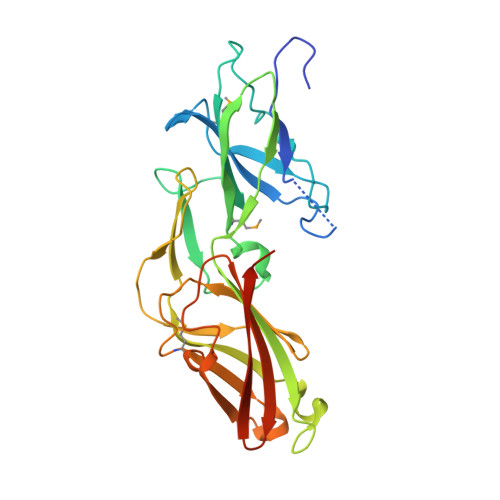A Distinct Type of Pilus from the Human Microbiome.
Xu, Q., Shoji, M., Shibata, S., Naito, M., Sato, K., Elsliger, M.A., Grant, J.C., Axelrod, H.L., Chiu, H.J., Farr, C.L., Jaroszewski, L., Knuth, M.W., Deacon, A.M., Godzik, A., Lesley, S.A., Curtis, M.A., Nakayama, K., Wilson, I.A.(2016) Cell 165: 690-703
- PubMed: 27062925
- DOI: https://doi.org/10.1016/j.cell.2016.03.016
- Primary Citation of Related Structures:
3LIU, 3PAY, 3R4R, 3SY6, 3T2L, 3UFI, 3UP6, 4DGU, 4EPS, 4GPV, 4H40, 4JG5, 4JRF, 4K4K, 4Q98, 4QB7, 4QDG, 4RDB, 5CAG - PubMed Abstract:
Pili are proteinaceous polymers of linked pilins that protrude from the cell surface of many bacteria and often mediate adherence and virulence. We investigated a set of 20 Bacteroidia pilins from the human microbiome whose structures and mechanism of assembly were unknown. Crystal structures and biochemical data revealed a diverse protein superfamily with a common Greek-key β sandwich fold with two transthyretin-like repeats that polymerize into a pilus through a strand-exchange mechanism. The assembly mechanism of the central, structural pilins involves proteinase-assisted removal of their N-terminal β strand, creating an extended hydrophobic groove that binds the C-terminal donor strands of the incoming pilin. Accessory pilins at the tip and base have unique structural features specific to their location, allowing initiation or termination of the assembly. The Bacteroidia pilus, therefore, has a biogenesis mechanism that is distinct from other known pili and likely represents a different type of bacterial pilus.
Organizational Affiliation:
Joint Center for Structural Genomics, http://www.jcsg.org; SLAC National Accelerator Laboratory, Stanford Synchrotron Radiation Lightsource, Menlo Park, CA 94025, USA.
















